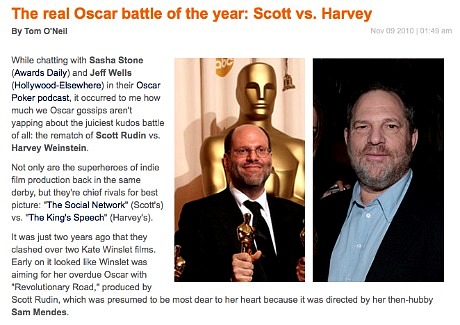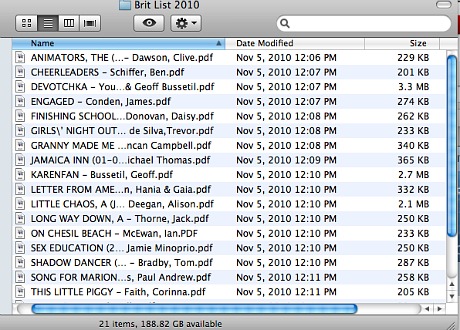Wells to Analog Kid and others who complained about what they felt was an overly-explicit review of Unstoppable: “All of the HE brainiacs who may be expecting a bad-ass Tony Scott thriller about a runaway train to end tragically with all kinds of death and dishonor and toxic poisoning are hereby notified that information to the contrary is contained in this review.”
First Crack at Fighter
David O. Russell’s The Fighter, which will have its first Manhattan press screening on Thursday, will screen for free tonight at L.A.’s AFI Fest 2010 at Grauman’s Chinese. The true-life based boxing drama costarring Mark Wahlberg, Christian Bale, Amy Adams and Melissa Leo will show at 9:30 p.m, which means that reviews from enterprising bloggers can be expected by midnight or 1 am Pacific.
“Admission to the screening will be available to AFI FEST 2010 passholders and the
general public through online ticket reservations at AFI.com/AFIFEST,” says an official announcement. Admission will also be available “via the rush line, which will begin forming one hour before the scheduled screening start time. All attendees are invited to walk the red carpet for the screening.”
Breasts and Buttocks
Time and again I’ve posted a famous quote from the legendary Michael O’Donoghue: “Simply making people laugh is the lowest form of humor.” Here’s another thought in this vein: “Calling a smart, highly spirited, deftly-constructed comedy ‘not funny enough’ is like meeting a bright and soulful and beautiful woman and saying her tits aren’t big enough and that her ass needs to be rounder.”

Rachel McAdams, Harrison Ford in Morning Glory
I’m sorry to use a crude analogy in an argument with the esteemed Marshall Fine, but his negative review of Roger Michell and Aline Brosh McKenna‘s Morning Glory isn’t that much different from a construction worker loudly commenting on the physical assets of a woman walking by a work site on 52nd street. He’s basically saying McKenna’s punch lines aren’t zippy or spritzy enough and that the laughs aren’t loud or frequent or horsey enough.
Well, let me tell you something: there is mirth and merriment and occasional howlers all through Morning Glory. It’s a film with chuckles, chortles, screamers, amusing banter, straight-ahead laughs, titters, rapier wit and plain likability. Not to mention story tension and believability and high-strung spirit and a touch of pathos and a considerable rooting factor in the case of Rachel McAdams‘ “Becky,” a morning-show producer.
There are other ways to skin a comedic cat than to try to maul an audience with laughter. Like fine fertilizer or seasoners or home-made salad dressing, Morning Glory‘s humor romances and enhances the whole. It fits in and fortifies. It is what it is according to its own plan, and is unmistakably present and pulsing from start to finish.
Breasts and buttocks of whatever size and shape can be very proportionately pleasing if not highly stimulating when evaluated within the particular scheme of a woman’s size and height and weight. And while their presence can and must be very important to men, their aesthetic importance tends to lessen and settle into reality the more you get to know the woman — i.e., who and what she is in terms of personality, character, loyalty and whatnot.
I’ll tell you what else is wrong with Fine’s “it’s not funny enough” complaint. If loud laughter from a given audience is your criteria, Adam Sandler‘s Just Go With It might, depending on the Jersey Shore Eloi factor in the seats, prove to be a “funnier” comedy than Morning Glory. In my book anyone who would then say “hey, go see the new Adam Sandler comedy because it’ll make you laugh more than Morning Glory“…well, that person would be the devil, plain and simple. Because a value judgment of this kind would have to be regarded as a small nail in the coffin of civilization as we once knew it.
"Look How They Massacred My Boy"
Created by Conan O’Brien and his writers. Performed by O’Brien, Jon Hamm, Larry King and others from central casting. Aired last night by TBS. And also posted last night (at 7:12 pm Pacific…hours before air time!) by Deadline‘s Nellie Andreeva.
Favoring Winds
Tom O’Neil has posted two Gold Derby pieces worth noting. One, the results of a recent Gold Derby poll showing that right now the odds seem to be overwhelming that King’s Speech star Colin Firth will win the Best Actor Oscar. And two, an idea that arose from Tom talking with Sasha Stone and myself during the recording of Oscar Poker #7, which is that the year’s juiciest kudos battle is the rematch of Social Network producer Scott Rudin vs. King’s Speech distributor Harvey Weinstein.

Perry Factor
Washington Post columnist Courtland Milloy feels that black men are portrayed horrifically in Tyler Perry‘s For Colored Girls. Milloy was “retching loudly,” he says, after seeing the film and “reading so many inexplicably glowing reviews.

“‘Oscar buzz, breaking news,’ read the Hollywood Reporter on Friday. ‘Will For Colored Girls blindside Tyler Perry’s critics?’ Too late. I was blindsided while watching the movie, especially when superstar Janet Jackson appeared onscreen looking like Michael Jackson with breast implants.”
Speed Reading
Last Thursday the 2010 Brit List, a selection of the hottest unproduced British and Irish screenplays, was released. A big fat file containing most of these scripts arrived in my inbox today. The Tracking Board says that the most popular is Jonathan Stern and Jamie Miniprio ‘s Sex Education. I took about ten minutes to flip through it…nope. Any others?

Mostly Okay With It
Todd McCarthy‘s thumbs-up review of Tony Scott‘s Unstoppable (20th Century Fox, 11.12) was posted yesterday afternoon, so I guess I can post mine also. My reaction is slightly less admiring than McCarthy’s. The first two-thirds of Unstoppable deliver first-rate popcorn pizazz, but the last third feels too manipulative.
WARNING: All of the HE brainiacs who may be expecting a bad-ass Tony Scott thriller about a runaway train to end tragically with all kinds of death and dishonor and toxic poisoning are hereby notified that information to the contrary is contained in this review.
Unstoppable is about a runaway train carrying toxic chemicals through the Pennsylvania rust belt and heading for a heavily-populated city that has a sharp curve in an elevated train track that might cause a derailment. It’s also about a slightly older engineer (Denzel Washington) and a young and somewhat brash conductor (Chris Pine) on another train in the general vicinity getting involved in a general effort to try and stop it.
Most of Unstoppable is as thrilling and jazzy and macho-adrenalized as I’d hoped after catching the trailer. Most. The fact that it has no villain is a relief, in a sense. Bad guys always means jaded histrionics, and it’s nice for a change to not have to deal with that. And yet — here’s the irony — it’s also a challenge to make an action movie go without a villain. Scott’s solution is to make it about metal and mettle and dependable charisma, about speed and logistics and air brakes and intra-company politics and three big train-track collisions or crashes. And about the hilly topography and moisture and worn-down, rust-belt ambiance of cold-weather Pennsylvania. Which I loved.
Scott throws in his usual high-end ingredients. The photography is by Ben Seresin (Transformers 2). The ace-level cutting by Robert Duffy and Chris Lebenzon. And the supporting characters have the usual attitude and vinegar — an alert dispatcher/coordinator (Rosario Dawson), a belligerent corporate stooge (Kevin Dunn), a doofus who caused the situation in the first place (Ethan Suplee), a train-system inspector (Kevin Corrigan), a brave railroad employee trying to chase down the runaway (Lew Temple). Put it all together and you’ve got something.
But the first 65% or 70% is better than the last 30% or 35%. Because for my money, Scott tries way too hard to get the audience to cheer in the last third. He won’t stop pushing for a rousing, stand-up-and-howl finale, and after a while you start to feel resentment. I don’t wanna cheer…see? Leave me alone, mug.
The backstory, character-arc stuff worked out for Denzel and Chris isn’t all that gripping, to be honest. It feels thin. Pine’s estranged wife, we’re told, has taken out a restraining order on him because he “scared” her. (And because he used a gun to confront the cop he wrongly suspected she was seeing?) Denzel is fearful and resentful at the railroad’s tendency to jettison older-guy veterans like himself, and his daughter is angry at him for forgetting to call on her birthday. None of this is especially compelling.
The media covers the runaway situation like a Super Bowl game. Everyone watching TV knows exactly what’s going on via chopper coverage, instant computerized visualization and breathless blow-by-blow commentary. And then it all works out (of course…are you expecting it to end with a 9/11-styled toxic disaster?) and the train eases to a stop and everyone is cheering their asses off. Denzel’s daughters think he’s cool again and Pine’s wife falls in love with him all over again and everything is peachy keen, and Suplee, we’re told, got fired and is now working in fast food. But it’s always a sign of weakness when a film uses one of those “this is what happened to the characters” epilogues.
But the first two-thirds of this film rock out. It’s sensationally shallow filmmaking of the best kind. And the last third is…well, it’s all right. I just wish Scott had trusted the bones of the story a bit more and not tried so hard to jack everyone up.
All in all it’s a well-cut, high-octane, jolt-cola movie. If you isolate the last third and think of the first 66 percent as the essence of Unstoppable (which of course you can’t), it’s the best big-hurtling-train thriller since John Frankenheimer‘s The Train (’64). The technical jargon, the gears, the braking systems, the throttles, the engine power, the rumble of these great iron beasts…it’s all great guy-movie stuff.
McCarthy writes that “Scott may have missed his mark by a bit on his last cinematic train ride with The Taking of Pelham One Two Three but he hits his target dead-on in Unstoppable. The best blue-collar action movie in who knows how long, this tense, narrowly focused thriller about a runaway freight train has a lean and pure simplicity to it that is satisfying in and of itself.
“But in its incidental portrait of discontented and discounted working stiffs who live marginal lives on society’s sidings and are angry to varying degrees, the film carries an unexpected weight and could connect with Middle American audiences in a big way.”
Arousal vs. Warmth
All the MCN Gurus of Gold except for Sasha Stone and Emanuel Levy are now predicting that The Kings Speech will beat The Social Network for the Best Picture Oscar. Where, I ask, are the men of backbone on this panel? They know damn well which film is the more dazzling and audacious and still they bend over. Capitulators! Conventional wisdom followers! Zeligs!
I truly admire and respect The King’s Speech, I do…it’s a very well made film, and true to itself above all. Colin Firth and Geoffrey Rush are close to perfect, and director Tom Hooper knew exactly how to get the most out of the material. But The King’s Speech has never made me feel aroused and dazzled and delighted like The Social Network has, and it never will. Be honest. It’s about comfort and tradition and respectablity and hugs. It’s the Best Picture of 1993.

